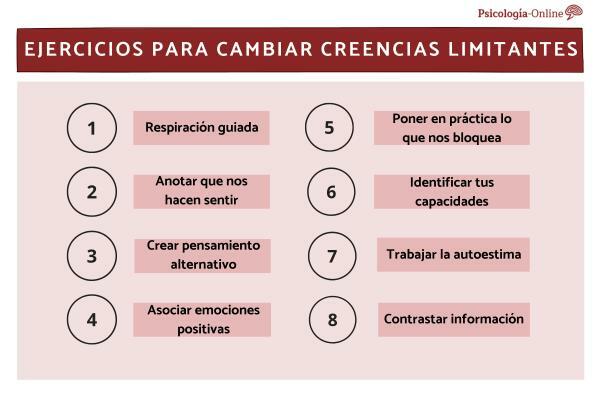
You may not identify the name limiting beliefs as your own, however, if you stop to think about all the thoughts that limit your daily life, you may feel more identified with these common beliefs in the present.
For example, thinking that we are not capable of achieving something, or simply that we do not deserve it, is part of the limiting beliefs. Therefore, in this Online Psychology article, we bring you 8 exercises to change limiting beliefs. Techniques such as the association of limiting beliefs with emotions, the creation of alternative beliefs, manage insecurities, work on self-esteem or contrast limiting beliefs with your beings dear. Read on to find out how to apply them!
Index
- What are limiting beliefs
- Identification of limiting beliefs
- Association of limiting beliefs to emotions
- Creation of alternatives
- Association of alternative beliefs to emotions
- Put into practice
- Managing insecurities
- Work self-esteem
- Information contrast
What are limiting beliefs.
Limiting beliefs are negative thoughts, that they do not have to be real, but that people consider them as such and block the achievement of objectives. Limiting beliefs can affect one area of life or all of them at the same time, since they generate insecurities and impede personal growth. These beliefs can arise from a harmful event or comment towards the person who suffers them.
Limiting belief types and examples
Three types of limiting beliefs can be distinguished:
- Possibility beliefs: they refer to the impossibility of achieving something concrete. For example: "My teammates will surely finish the race on time, but I'm not going to be able to get it."
- Capability beliefs: they focus on highlighting the capabilities of others, underestimating their own. For example: "My sister is capable of managing her work and family life at the same time, and I am incapable of just doing my job well."
- Beliefs of worthiness: They are based on thinking that we do not deserve the achievements that we are achieving for the mere fact of not feeling that enough has been sacrificed. For example: "I don't deserve the promotion because I haven't worked enough this year."
Identification of limiting beliefs.
One of the exercises to change limiting beliefs is to do a guided breathing through self-instruction, that is, indications that we are giving ourselves. Here's how to do it:
- We tell ourselves that we are going to breathe slowly, taking air through our nose for 5 seconds.
- We feel the air passing into our throat and we expel in 7 seconds.
- When we have relaxed we can focus our attention on our thoughts. This is when we have to reflect on what kinds of thoughts are limiting us.
- Being able to identify limiting beliefs is the first step in working on them.

Association of limiting beliefs to emotions.
This second exercise to identify limiting beliefs is based on write them down and stop at each one of them to detect what they make us feel. There are two different options for carrying out the exercise:
- Write down all the limiting beliefs and then analyze them one by one.
- Analyze each belief that is noted down, and work them one by one.
Both options are equally valid, since the ultimate goal of this exercise is to be able to associate an emotion with each of the limiting beliefs. For example, associating the limiting belief "I can't get a job" with frustration or helplessness.
If you find it difficult to identify your emotions, you can consult this article on the types of emotions and their meaning.
Creation of alternatives.
If you are wondering how to change limiting beliefs, this exercise focuses on create alternative thinking for each of limiting beliefs. For example, going from “I don't have enough skills to get a university degree” (belief limiting) to "sure that if I am constant in my studies I will be able to get my degree" (belief alternative).
This exercise is usually more complicated, since people who have many limiting beliefs tend to have little developed mental flexibility. The ultimate goal is for the person to learn to focus attention on positive aspects.
Association of alternative beliefs to emotions.
The main objective of this exercise to change the limiting beliefs is that the person who associates the emotions realizes that when thinking through the alternative beliefs, the emotions they perceive are positive and more rewarding. For example, associating "if I work hard, I'll get to buy the car I need" with satisfaction or personal pride.

Put into practice.
How can limiting beliefs be modified? It is about taking the step to do what our limiting beliefs try to block us, that is, face the situation that we think we are not capable of and deal with that feeling of incapacity. The goal is to show ourselves that we are capable and that everything is possible with effort and practice.
This exercise to change limiting beliefs is usually carried out in the fifth place, since you must first work on limiting beliefs as such and manage to produce alternatives that facilitate the implementation of practice.
Management of insecurities.
Limiting beliefs are often related to insecurities and / or lack of self-esteem. Therefore, it is very important to also work on insecurities. This can be done through a capabilities identification exercise, that is, the person would have to make a table with three columns and write down the qualities in each of them and capacities that he has, the good things that he does in his day to day and what successes or achievements they have achieved until moment.
One of the exercises to change limiting beliefs that is fundamental so that the person can have a visual image of all the positive aspects that surround him in his daily life. If you need other tools to achieve it, in this article, we will tell you how to overcome insecurity.
Work on self-esteem.
As mentioned in the previous section, self-esteem is a factor that is directly related to the formation of limiting beliefs. Therefore, one of the most important limiting beliefs changing exercises is based on create a schedule of routines in which pleasant and interesting activities are added that promote leisure and distraction of the person. The activities to be added can be cultural, leisure or relaxing, among others, but above all they must satisfy the person.
In this article you will find other techniques and exercises to improve self-esteem.

Information contrast.
To finish working on limiting beliefs, it is important to do this exercise. Specifically, it focuses on social relationships and development of communication with the people we love and who else know us.
Basically, it consists of having a conversation with the people we appreciate the most to contrast limiting beliefs. This exercise allows dismantling these beliefs and generating more adaptive alternative beliefs.
Limiting beliefs can negatively affect the development of our daily life. If you try to work on these beliefs without success, and they continue to cause you discomfort and limit the achievement of objectives, do not hesitate to go to a psychology professional that can accompany you in this process and give you the tools and strategies necessary to improve your day-to-day life.
This article is merely informative, in Psychology-Online we do not have the power to make a diagnosis or recommend a treatment. We invite you to go to a psychologist to treat your particular case.
If you want to read more articles similar to Exercises to change limiting beliefs, we recommend that you enter our category of Cognitive psychology.
Bibliography
- Alberto Bracho Herrera. (2018). How to identify your limiting beliefs to change them. Recovered from Irradia Terapia Mexico. https://psicologos.mx/como-identificar-tus-creencias-limitantes-para-cambiarlas.php
- Barragán de la Parra, R. (2012). Our beliefs, limiting or potentializing? Available in: http://repositorio.iberopuebla.mx/bitstream/handle/20.500.11777/1673/Nuestras+creencias,+limitantes+o+potenciadoras.pdf? sequence = 1
- Vera Sánchez, A. (2013). Limiting beliefs. Available in: http://repositorio.iberopuebla.mx/bitstream/handle/20.500.11777/1834/Creencias+limitantes.pdf? sequence = 1


